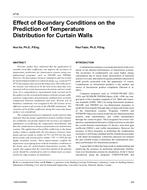Description
Previous studies have indicated that the application of variable local film coefficients can improve the accuracy of temperature predictions for fenestration systems using two-dimensional programs, such as FRAME and THERM. However, the discrepancy between simulation and test results for metal-framed windows is relatively large, e.g., a typical 5oC (9oF) discrepancy may exist in the frame area. One of the possible reasons was believed to be the lack of test data that were reported with accurate measurement locations and test conditions. In a comprehensive experimental study carried out by the authors on the overall performance of metal curtain walls, extensive temperature measurements enabled more accurate comparison between simulations and tests. Several sets of boundary conditions were assigned to the sill sections of two different curtain wall systems in the FRAME simulations. The variation of local film coefficients along the room-side frame surface was considered.
The comparison between simulation results and test data indicates that the proper application of more realistic boundary conditions can greatly improve the accuracy of computer simulations in predicting the temperature distributions and thus the condensation resistance performance for fenestration systems. The application of local film coefficients to the frame surface reduces significantly the discrepancy between simulation and test results to within +-0.5°C (+-0.9°F) for the standard curtain wall system and to within +2°C (+3.6°F) for the highly insulated system. These improvements confirm the importance of assigning more realistic boundary conditions to the frame area for metal-framed fenestration systems. The results also suggest that the convection motion in the glazing cavity should be considered in order to obtain more accurate results for edge-of-glass in simulations.
Units: Dual
Citation: ASHRAE Transactions, vol. 110, pt. 2
Product Details
- Published:
- 2004
- File Size:
- 1 file , 400 KB
- Product Code(s):
- D-23215




